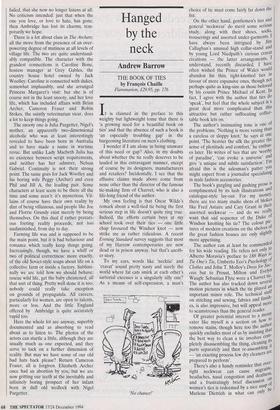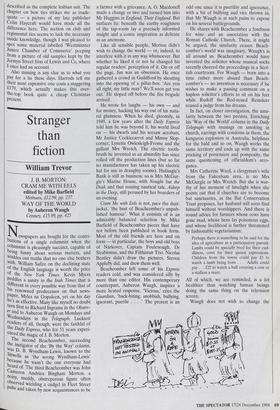Hanged by the neck
Andrew Barrow
THE BOOK OF TIES by Francois Chaille Flammarion, £29.95, pp. 176 It is claimed in the preface to this weighty but lightweight tome that there is `a growing need for a beautiful book on ties' and that the absence of such a book is `an especially troubling gap' in the burgeoning literature on men's clothing.
I wonder if I am alone in being unaware of this need or gap? Also, in my doubts about whether the tie really deserves to be lauded in this extravagant manner, except of course by its designers, manufacturers and retailers? Incidentally, I see that the effusive claims made above come from none other than the director of the famous tie-making firm of Charvet, who is also a life-long friend of the author.
My own feeling is that Oscar Wilde's remark about a well-tied tie being the first serious step in life doesn't quite ring true. Indeed, the efforts certain boys at my school took over their ties — one little chap favoured the Windsor knot — now strike me as rather ridiculous. A recent Evening Standard survey suggests that most of my Harrow contemporaries are now dead or in prison anyway, but that's anoth- er story.
To my ears, words like 'necktie' and `cravat' sound pretty nasty and surely the world where fat cats smirk at each other's sartorial excesses is a singularly silly one? As a means of self-expression, a man's
`No chance!'
choice of tie must come fairly far down the list.
On the other hand, gentlemen's ties and general 'neckwear' do merit some serious study, along with their shoes, socks, trouserings and assorted under-garments. I have always been intrigued by Jim Callaghan's unusual high collar-stand and by young Lord Niedpath's curious cravat creations — the latter arrangements, understand, recently discarded. I have often wished the Prince of Wales would abandon his thin, tight-knotted ties in favour of more expansive ones, though not perhaps quite as king-size as those beloved by his cousin Prince Michael of Kent. In fact, I agree with the author that ties do `speak', but feel that the whole subject is a great deal more complicated than this attractive but rather suffocating coffee- table book lets on. The author's insinuating tone is one of the problems. 'Nothing is more vexing than a careless or sloppy knot,' he says at one point. 'The heavier the silk the greater the sense of plenitude and comfort,' he enthus- es later. He writes of ties that are 'worthy of paradise', 'can evoke a universe' and give 'a unique and subtle satisfaction'. I'm afraid this is the salesman's patter you might expect from a journalist specialising in male fashion accessories. The book's gurgling and gushing prose i5 complimented by its lush illustrations and catalogue-style lay-out. For my money, there are too many studio shots of blokes like Fred Astaire and Cary Grant in their assorted neckwear — and do we really want that sad sequence of the Duke of Windsor knotting his tie? The colour pic- tures of modern creations on the shelves of the great fashion houses are only slightly more appetising. The author can at least be commended for his wide reading. He refers not only to Alberto Moravia's preface to 188 Ways to Tie One's Tie, Umberto Eco's Psychology of Clothes and John T. Molloy's Dress for Suc- cess but to Proust, Milton and Evelyn Waugh: Sebastian Flyte wore a Charvet tie. The author has also tracked down several motion pictures in which the tie played a1 important minor role. The technical sMil on stitching and sewing, fabrics and finish- es, is also impressive, but will appeal more to seamstresses than the general reader. Of greater potential interest to a messy eater like myself is a section on how to remove stains, though here too the authol quickly excludes most of us by insisting dial the best way to clean a tie involves its
corn
pletely disassembling the thing, cleaning parts separately and then re-assembling t, — 'an exacting process few dry cleaners are prepared to perform'. There's also a handy reminder that over- tight neckwear can cause migraine, headaches, nasal congestion and deafness, and a frustratingly brief discussion Or women's ties is redeemed by a nice snap be Marlene Dietrich in what can only Dv described as the complete lesbian suit. The chapter on bow ties strikes me as inade- quate — a picture of my late publisher Colin Haycraft would have made all the difference here. The section on club and regimental ties seems to lack the necessary inside knowledge, though I was pleased to spot some material labelled 'Westminster Junior Chamber of Commerce' peeping from a picture of old samples kept by the Jermyn Street firm of Lewin and Co, where I once had an account.
Also missing is any clue as to what you pay for a tie these days. Harrods tell me their most expensive one costs a staggering £179, which actually makes this over- the-top book quite a cheap Christmas present.











































































































 Previous page
Previous page